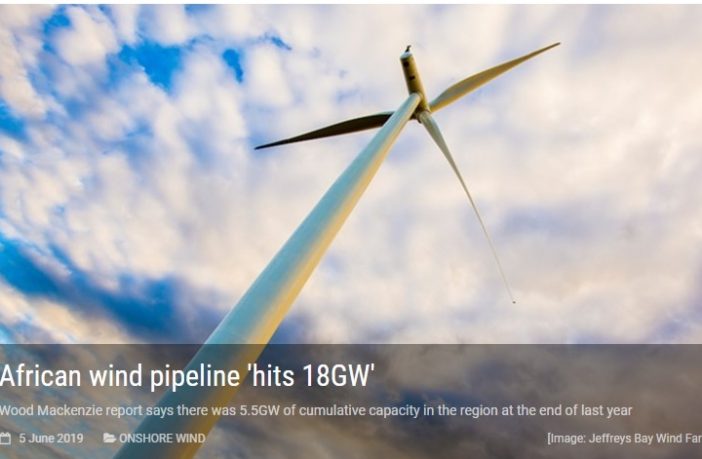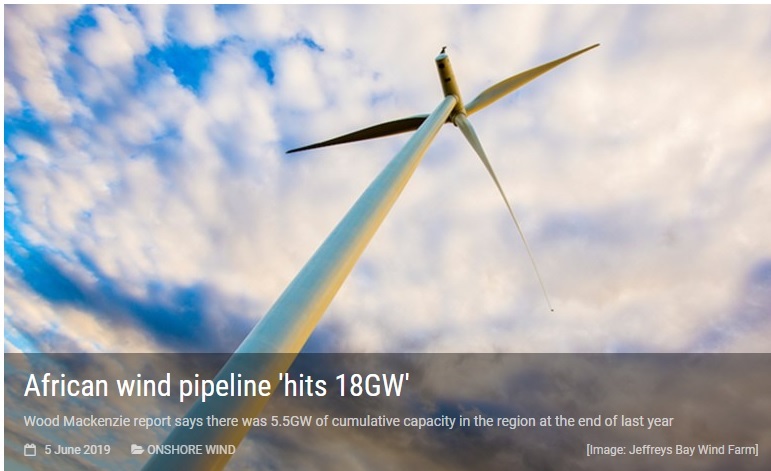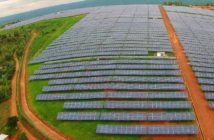Renewable Energy News
Africa’s wind project pipeline stood at 18GW at the end of the first quarter of 2019, according to a new report by Wood Mackenzie Power & Renewables.
Some 6.5GW is at an advanced stage of development, although the report – ‘Africa wind power market outlook 2019’ – noted that the project realisation rate remains low in the region.
At the end of 2018, the cumulative capacity in Africa was 5.5GW, it added.
Demand in South Africa is one of the main drivers for wind energy on the continent, with the country expected to have over 1GW under construction in 2020 and 2021.
In the long term, South Africa has a target for more than 10GW of additional wind power capacity through to 2030, the report added.
Wood Mackenzie Power & Renewables senior analyst Sohaib Malik said: “Africa’s most industrialised economy, South Africa, boasts its largest wind power market, with 2.1GW of operational capacity as of Q1 2019.
“Issues with governance that took place in 2016 and 2017 were bad news for the local wind market, as no new additions were recorded in 2018.
“However, installations are expected to recommence in 2019 with 130MW of new capacity additions on tap, though potential project delays jeopardise that capacity and limit any upside potential for additional capacity.
“Growth prospects improve thereafter, with more than 1GW of capacity expected in 2020 and 2021 combined.
“This outlook is supported by ongoing construction activity, peaking in 2020 as IPPs race to achieve commercial operations.”
Overall, projects were commissioned in just four markets in 2018, the report said.
Malik said: “The scale of the development pipeline underlines the ability of the continent’s largest wind markets to grow in a sustained manner, providing a blueprint for emerging markets to tap their wind potential and fuel economic growth.”
He added that there is a growing momentum behind the development of long-term incentive mechanisms to support the wind market.
“Competitive procurement has proven to be the favoured tool of policy support, with South Africa and Morocco introducing auction programs in 2011 and 2015, respectively,” he said.
“Tunisia solicited bids for wind IPPs in 2017, while Kenya and Ethiopia are contemplating the launch of auctions for future installations.
“These developments mirror global trends where competitive procurement regimes have resulted in lower tariffs in many countries.
“Notably, this trend may be less impactful in emerging markets, which are expected to grow by less than 800MW of capacity through 2028, as auction volumes may not be sufficient to draw the attention of global wind industry leaders.”
Other countries driving growth are Egypt and Morocco, but more clarity is needed in these markets.
Malik said: “Several leading international developers are executing projects with anticipated commissioning in the near future.
“Consequently, a wind IPP market will be established in Egypt with 1.3GW of capacity. Similarly, the commissioning of 1GW of wind capacity in Morocco, awarded between 2012 and 2016, will enhance IPPs’ role in this market.
“It’s necessary for both countries to take measures to consolidate their success.
“For example, Morocco needs to introduce new rounds of auctions no later than early 2020s and the Egyptian government should implement a more rigorous policy framework for the long-term development of its wind power market.”
He added that Ethiopia, Tunisia, Kenya, Algeria and Ghana also offer potential for project development.








